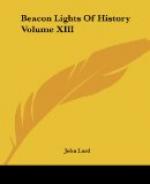The work to which Carlyle now devoted himself was a history of the French Revolution, the principal characters of which he had already studied and written about. It was a subject adapted to his genius for dramatic writing, and for the presentation of his views as to retribution. His whole theology, according to Froude, was underlaid by the belief in punishment for sin, which was impressed upon his mind by his God-fearing parents, and was one of his firmest convictions. The French were to his mind the greatest sinners among Christian nations, and therefore were to reap a fearful penalty. To paint in a new and impressive form the inevitable calamities attendant on violated law and justice, was the aspiration of Carlyle. He had money enough to last him with economy for two years. In this time he hoped to complete his work. The possibility was due to the intelligent thrift of his wife. Commenting on one of her letters describing their snug little house, he writes:—
“From birth upwards she had lived in opulence; and now, for my sake, had become poor,—so nobly poor. Truly, her pretty little brag [in this letter] was well founded. No such house, for beautiful thrift, quiet, spontaneous, nay, as it were, unconscious—minimum of money reconciled to human comfort and human dignity—have I anywhere looked upon.”
He devoted himself to his task with intense interest, and was completely preoccupied.
In the winter of 1835, after a year of general study, collection of material and writing, and at last “by dint of continual endeavor for many weary weeks,” the first volume was completed and submitted to his friend Mill. The valuable manuscript was accidentally and ignorantly destroyed by a servant, and Mill was in despair. Carlyle bore the loss like a hero. He did not chide or repine. If his spirit sunk within him, it was when he was alone in his library or in the society of his sympathizing wife. He generously writes to Emerson,—
“I could not complain, or the poor man would have shot himself: we had to gather ourselves together, and show a smooth front to it,—which happily, though difficult, was not impossible to do. I began again at the beginning, to such a wretched, paralyzing torpedo of a task as my hand never found to do.”
Mill made all the reparation possible. He gave his friend L200, but Carlyle would accept only L100. Few men could have rewritten with any heart that first volume: it would be almost impossible to revive sufficient interest; the precious inspiration would have been wanting. Yet Carlyle manfully accomplished his task, and I am inclined to think that the second writing was better than the first; that he probably left out what was unessential, and made a more condensed narrative,—a more complete picture, for his memory was singularly retentive. I do not believe that any man can do his best at the first heat. See how the great poets revise and rewrite. Brougham




